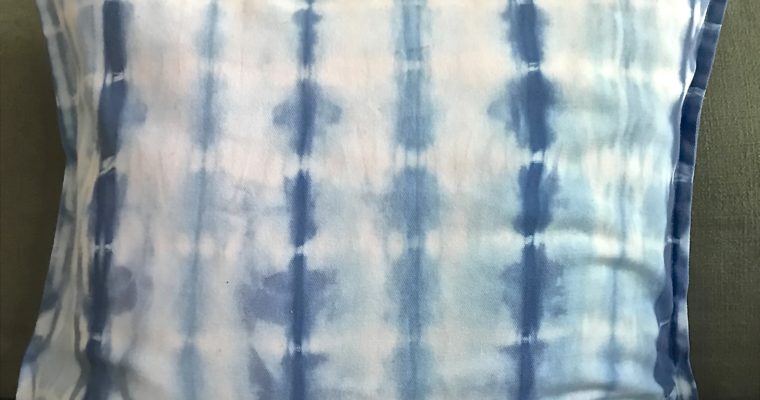Sashiko is a form of decorative reinforcement stitching or functional embroidery from Japan. White cotton thread on the traditional indigo blue cloth gives Sashiko its distinctive appearance.
Shibori is a Japanese dye technique that typically involves folding, twisting or bunching cloth and binding it, then dye the fabric in indigo.
I have been looking at Sashiko and Shibori how to tutorials on Pinterest for years! I love the look of these traditional crafts so much, and the fact that both crafts use Indigo as the main color, you know I love it! What I haven’t loved is the price I’ve seen. There had to be an alternative, an easy way to get the look for much less.

This is the first set of pillow covers that I crafted. I have done one more set since- I loved these so much! Also I am not going to give a traditional tutorial, Pinterest and Youtube have lots you can look up. But I will give a brief explanation of my take on these fun and easy crafts. Believe me when I say these were easy and straight forward. I am certain that anyone can do them! Can you thread a needle? Can you twist a rubber band? Then You too can do these crafts!

This first Shibori pillow cover most closely resembles a Tie Dye T-shirt. And if you have made one of those at Summer Camp, you can do this cover. I took a plain white cover, and found the center. I started by pulling the center into the first rubber band and folded the rest of the cover into pleats. Folding and crimping the fabric so that there would be some even edges exposed to the dye. The one tip I can give you, that I think many forget, is that everything under the rubber band or in the folds will stay white. Every where that there is fabric showing will absorb the dye and be darker. Once I had the pleats, I added more rubber bands evenly all the way to the end. I really love how this cover came out, perfect rings of white in Sunshine rays of blues!

This second pillow cover is my take on Sashiko. A Traditional Boro is pieced together Indigo fabric with white Sashiko stitches. For my take I turned it the other way around. I used Blue threads on a White cover. I used some embroidery thread I already had, and another white pillow cover. Then I simply made running stitches across the cover. I would change the color every once in a while to add more interest. This project did take some time, as I did the stitching on both sides. But I think that it was well worth the time and energy.

Lastly, is the third Shibori cover and this one is my favorite. I am so in love with how it turned out. This Shibori pattern looks like it would be complicated, but its so not! All you have to do is fold the cover in the accordion fold, or zig zag folds. That way it will have lots of fabric exposed to the dye. And once again rubber bands evenly spaced out to the end. My second tip with Tie Dye is to let it sit in the dye at least overnight, if not for two or more days. This helps the dye become brighter and stays longer. Just put it in a gallon size zip lock bag, or a bucket with a lid.

Well, I hope that helps. I hope it gives you the confidence to try these fun, beautiful and traditional crafts yourself! Please email me if you have any questions. I will do my best to help you out. But, also be sure to do your research and find a technique that your comfortable with. I’m not an expert, I just love to craft! Because how hard can it be???
Jackie
I used Rit Dye from the craft store and the white Pillow Covers are from Ikea.
